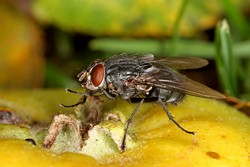Molecular interaction in symbiosis
P. carotovorum ECC15, a new strain, has a rare gene, the Erwinia virulence factor (EVF). A rare interaction, this gene makes it possible for the bacterium to survive in the mid-gut of the fly. As these symbiotic relationships can play major roles – from nutrient acquisition to protection against predators – the study of these fascinating relationships could shed light on important signalling systems. The BACTINSECT (Molecular mechanisms in the establishment of disease transmission by invertebrate vectors) project studied the molecular mechanisms behind monospecific bacterial-host interactions. The crystal structure of EVF has been previously determined but lack of biochemical characterisation has hampered further progress. The BACTINSECT team devised a way to see how EVF impacts on Drosophila melanogaster larvae. Grubs fed on wild type P. carotovorum ECC15 showed delayed development compared to larvae on the bacterium with EVF. In collaborative work, the researchers also investigated the role of so-called quorum sensing (QS) or chemical communication between bacterial cells in the interactions. QS could have many roles in bacterial fitness and may even contribute to oxidative stress tolerance. The plant pathogen P. wasabiae has two cell-to-cell signalling networks that control the expression of plant cell wall degrading enzymes, key to its pathogenicity. Research results revealed that in mixed bacterial communities, P. wasabiae can rely on the signalling molecules from other species to produce regulatory small RNA that are responsible for virulence. Symbiosis is an important adaptive process. This allows bacteria to colonise very diverse environments including places normally prohibitive to other life forms in terms of temperature and pH, for example. Study of the molecular mechanisms behind these delicate interactions could help us understand the conditions required for infection in human disease and provide control strategies for plant pathogens.
Keywords
Symbiosis, Pectobacterium carotovorum, Erwinia virulence factor, quorum sensing, human disease

